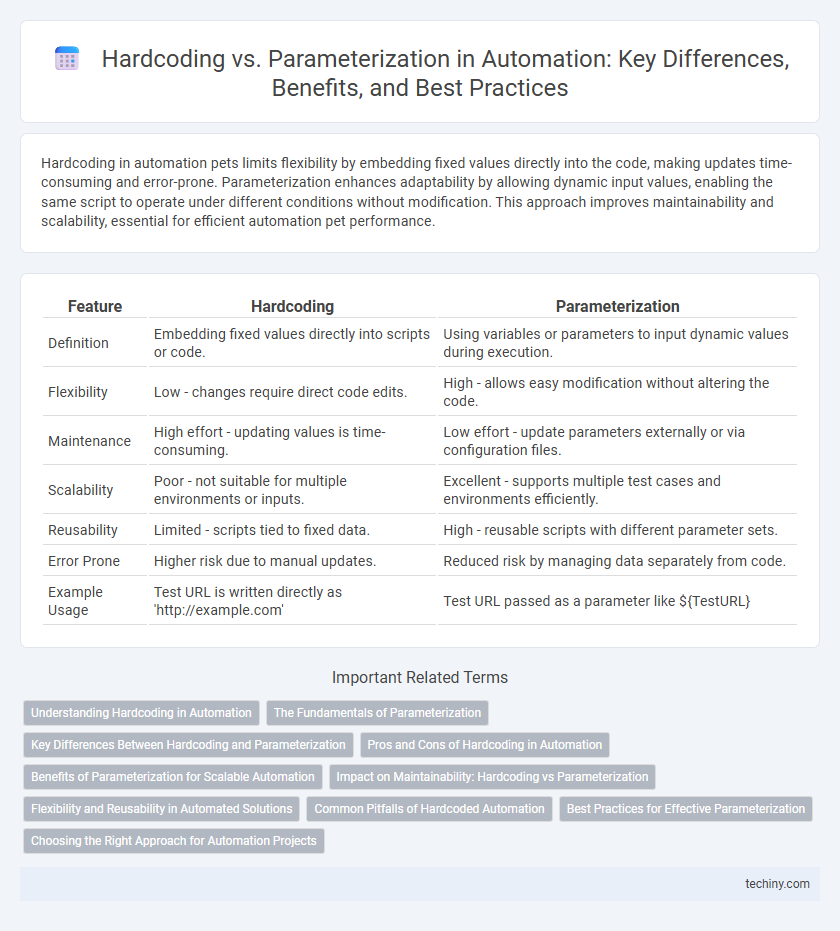Hardcoding in automation pets limits flexibility by embedding fixed values directly into the code, making updates time-consuming and error-prone. Parameterization enhances adaptability by allowing dynamic input values, enabling the same script to operate under different conditions without modification. This approach improves maintainability and scalability, essential for efficient automation pet performance.
Table of Comparison
| Feature | Hardcoding | Parameterization |
|---|---|---|
| Definition | Embedding fixed values directly into scripts or code. | Using variables or parameters to input dynamic values during execution. |
| Flexibility | Low - changes require direct code edits. | High - allows easy modification without altering the code. |
| Maintenance | High effort - updating values is time-consuming. | Low effort - update parameters externally or via configuration files. |
| Scalability | Poor - not suitable for multiple environments or inputs. | Excellent - supports multiple test cases and environments efficiently. |
| Reusability | Limited - scripts tied to fixed data. | High - reusable scripts with different parameter sets. |
| Error Prone | Higher risk due to manual updates. | Reduced risk by managing data separately from code. |
| Example Usage | Test URL is written directly as 'http://example.com' | Test URL passed as a parameter like ${TestURL} |
Understanding Hardcoding in Automation
Hardcoding in automation refers to embedding fixed values directly within scripts or code, limiting flexibility and adaptability in dynamic testing environments. This practice can lead to increased maintenance effort and reduced scalability when test inputs or configurations need frequent updates. Employing parameterization instead enhances test automation by allowing reusable and data-driven test cases, improving efficiency and robustness.
The Fundamentals of Parameterization
Parameterization involves using variables to replace hardcoded values in automation scripts, enhancing flexibility and reusability. By defining parameters externally, such as in configuration files or test data sources, scripts adapt dynamically to different environments and inputs without code modification. This approach significantly reduces maintenance effort and increases test coverage by enabling easy iteration through diverse data sets.
Key Differences Between Hardcoding and Parameterization
Hardcoding involves embedding fixed values directly into the automation script, limiting flexibility and requiring code modifications for changes. Parameterization replaces static data with dynamic variables, enabling the reuse of scripts across various datasets and enhancing maintainability. This approach significantly improves test coverage and reduces script duplication by separating data from logic.
Pros and Cons of Hardcoding in Automation
Hardcoding in automation scripts offers simplicity and quick implementation by embedding fixed values directly into the code, which reduces initial setup time. However, it limits flexibility and scalability since any change requires modifying the source code, increasing maintenance efforts and the risk of errors during updates. Hardcoded automation is less adaptable to dynamic environments, making it unsuitable for complex or large-scale test frameworks where parameterization enhances reusability and efficiency.
Benefits of Parameterization for Scalable Automation
Parameterization in automation enables reusable and adaptable test scripts by allowing input values to be defined externally, significantly reducing maintenance efforts and enhancing test coverage. It supports scalability by facilitating the execution of the same test scripts across multiple data sets and environments without code modifications. This approach accelerates test execution, improves consistency, and promotes efficiency in large-scale automation frameworks.
Impact on Maintainability: Hardcoding vs Parameterization
Hardcoding negatively impacts maintainability by embedding fixed values directly into the code, making updates time-consuming and error-prone when changes are required. Parameterization improves maintainability by allowing dynamic input values, enabling easier adjustments and reducing the need for code modification. Automated tests and scripts become more scalable and adaptable with parameterization, leading to efficient long-term maintenance.
Flexibility and Reusability in Automated Solutions
Hardcoding in automation limits flexibility by embedding fixed values directly within scripts, reducing adaptability to varying environments and inputs. Parameterization enhances reusability by allowing dynamic input values, enabling the same automated solution to operate across multiple scenarios without code modification. This approach streamlines maintenance and supports scalable, efficient automation frameworks.
Common Pitfalls of Hardcoded Automation
Hardcoded automation scripts often lead to maintenance challenges due to inflexible values embedded directly in the code, causing frequent breakage when system variables change. This lack of scalability results in increased testing effort and delays, as each modification requires manual code adjustments. Parameterization mitigates these issues by enabling reusable, dynamic inputs that enhance test robustness and reduce the risk of errors.
Best Practices for Effective Parameterization
Best practices for effective parameterization in automation emphasize using external configuration files, environment variables, or centralized test data repositories to avoid hardcoding values directly in scripts. Parameterization enhances test maintainability, scalability, and reusability by allowing easy updates and variations without changing code. Incorporating clear naming conventions and validation mechanisms for parameters ensures robustness and reduces the risk of errors during automated test execution.
Choosing the Right Approach for Automation Projects
Hardcoding simplifies initial automation by embedding fixed values directly into scripts, but limits flexibility and maintenance across changing environments. Parameterization enhances scalability by allowing dynamic input through variables, enabling tests to run with diverse data sets and configurations. Selecting between hardcoding and parameterization depends on project complexity, frequency of change, and the need for reusable, adaptable automation solutions.
Hardcoding vs Parameterization Infographic

 techiny.com
techiny.com